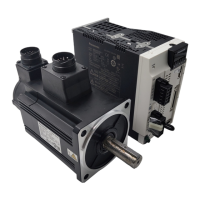5-48
5. Manual Gain Tuning (Application)
Feed forward function
Usage example of velocity feed forward
The velocity feed forward will become effective as the velocity feed forward gain is
gradually increased with the velocity feed forward lter set at approx. 50 (0.5 ms). The
positional deviation during operation at a constant velocity is reduced as shown in the
equation below in proportion to the value of velocity feed forward gain.
Positional deviation [unit of command] = command speed [unit of command/s] /
positional loop gain [1/s] × (100 - velocity feed forward gain [%]) / 100
Command speed
Motor speed
Pos t ona dev at on
Ve oc ty feed forward ga n
0[%]
50[%]
80[%]
Time
Positional deviation within the
constant speed range will
reduce as the velocity
forward gain is increased.
With the gain set at 100 %, calculatory positional deviation is 0, but signicant overshoot
occurs during acceleration/deceleration.
If the updating cycle of the positional command input is longer than the driver control
cycle, or the pulse frequency varies, the operating noise may increase while the velocity
feed forward is active. If this is the case, use positional command lter (1st delay or FIR
smoothing), or increase the velocity forward lter setup value.
Usage example of torque feed forward
• To use the torque feed forward, correctly set the inertia ratio.
Use the value that was determined at the start of the real time auto tuning, or set the
inertia ratio that can be calculated from the machine specication to Pr0.04 Inertia ratio.
• The torque feed forward will become effective as the torque feed forward gain is
gradually increased with the torque feed forward lter is set at approx. 50 (0.5 ms).
• Positional deviation at a constant acceleration/deceleration can be minimized close
to 0 by increasing the torque forward gain. This means that positional deviation can
be maintained at near 0 over entire operation range while driving in trapezoidal speed
pattern under ideal condition where disturbance torque is not active .
Command speed
Positional deviation
0[%]
50[%]
100[%]
Time
Motor speed
Torque feed forward
gain
Velocity feed forward gain = Fixed 100[%]
Positional deviation in the
region where acceleration
is constant can be reduced
by torque feed forward.
Zero positional deviation is impossible in actual situation because of disturbance torque.
As with the velocity feed forward, large torque feed forward lter time constant decreases
the operating noise but increases positional deviation at acceleration change point.
Buy: www.ValinOnline.com | Phone 844-385-3099 | Email: CustomerService@valin.com

